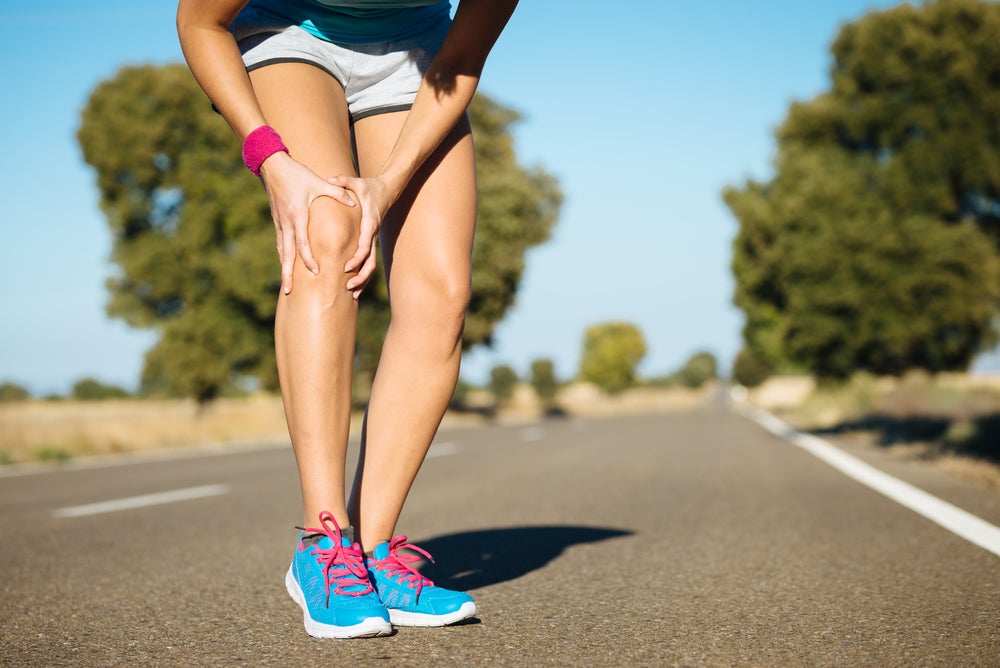Treating And Preventing Knee Ligament Sprains

Photo: Shutterstock.com
Suspect you may have injured a ligament in your knee? Here’s how to fix it and protect your knees in the future.
A knee ligament sprain is characterized by pain at the time of the injury (usually caused by an impact) and varying levels of pain afterward depending on the severity. The location of the pain also depends on which knee ligament is damaged. Some swelling is common, as is joint instability, which makes you feel as if your knee might give out.
There are four main ligaments in the knee that keep the femur attached to the fibula and tibia in the lower leg. One or more of these ligaments can be sprained at the same time. However, each ligament is vulnerable to certain impacts to the knee.
Medial collateral ligament (MCL): On the inner side of the knee, this is the most commonly sprained ligament. Pain will be localized on the inner portion of the knee after a hit to the outer side of the knee.
Lateral collateral ligament: On the outer side of the knee, this is the counterpart of the MCL.
Anterior cruciate ligament (ACL): One of two crossing ligaments inside the knee joint that attach the femur to the tibia. The anterior is the one closest to the front of the knee. It’s most commonly hurt when the knee twists and the foot remains planted.
Posterior cruciate ligament (PCL): The other crossing ligament inside the knee, this one running behind the ACL. It’s thicker and stronger than the ACL, so it isn’t injured as often. An impact on the front of the tibia while the knee is bent is the most common cause of a sprain.
Fix It
See a doctor. Any knee injury needs a diagnosis. The fact is, even if you suspect a sprain, you could have other damage that needs attention. These decisions and diagnoses should be made by your doctor, not you.
Employ dynamic rest. Avoid loading the knee and continue with intense upper-body and core work to maintain fitness.
Ice it. Apply ice for 15 minutes every 4 to 6 hours for the first two days to alleviate swelling. Elevating the knee above your heart can also help with swelling.
Try an NSAID. An anti-inflammatory like ibuprofen or naproxen can help with pain and inflammation.
Rehab and strengthen. When pain subsides and activity can resume, perform mobility and balance exercises to improve joint stability and leg strength. A good start for basic strengthening: uphill walking, cycling or pool running. When you’re pain free, build up all of your leg muscles with multidirectional lunges and squats. If you experience any pain, back off.
Prevent It
You may not be able to prevent an impact to your knee. But the strength and flexibility of your legs will help determine how quickly you’ll recover if the problem isn’t surgical. The exercises below all help build powerful legs and can be added to any workout.
RELATED – DIY Diagnosis: Runner’s Knee Vs. Iliotibial Band Syndrome
Exercise #1: Squat Thrusts
Stand with your feet shoulder-width apart and your arms at your sides (dumbbells optional). Push your hips back, bend your knees, and lower your body as deep as you can into a squat. As you squat down, place your hands on the floor in front of you as you kick your legs backward so that you’re in a push-up position. Quickly bring your legs back to the squat position. Stand up quickly and repeat the movement.
RELATED: 4 Exercises to Treat And Prevent Achilles Tendinitis
Exercise #2: Bodyweight Jump Squats
Place your fingers on the back of your head and pull your elbows back. Perform a bodyweight squat until your thighs are parallel to the floor, then explosively jump as high as you can (imagine you’re pushing the floor away from you as you leap). When you land, immediately squat and jump again. Hold dumbbells at your side to make it more challenging.
REALTED: Take Care Of Your Quads
Exercise #3: Low Side-To-Side Lunge
Stand with your feet set about twice shoulder-length apart, your feet facing straight ahead. Clasp your hands in front of your chest (dumbbells optional). Shift your weight over to your right leg as you push your hips backward and lower your body. Your lower right leg should remain nearly perpendicular to the floor and your left foot should remain flat. Without raising yourself back up to a standing position, reverse the movement to the left. Alternate back and forth.
From The Athlete’s Book of Home Remedies by Jordan D. Metzl, M.D. with Mike Zimmerman. Copyright 2012 by Rodale Inc. Published by arrangement with Rodale, Inc., Emmaus, PA 18098.
New York City sports medicine specialist Jordan D. Metzl, M.D. is a 33-time marathon finisher and 13-time Ironman. His book, The Athlete’s Book of Home Remedies, has more than 1,000 tips to fix all types of injuries and medical conditions.